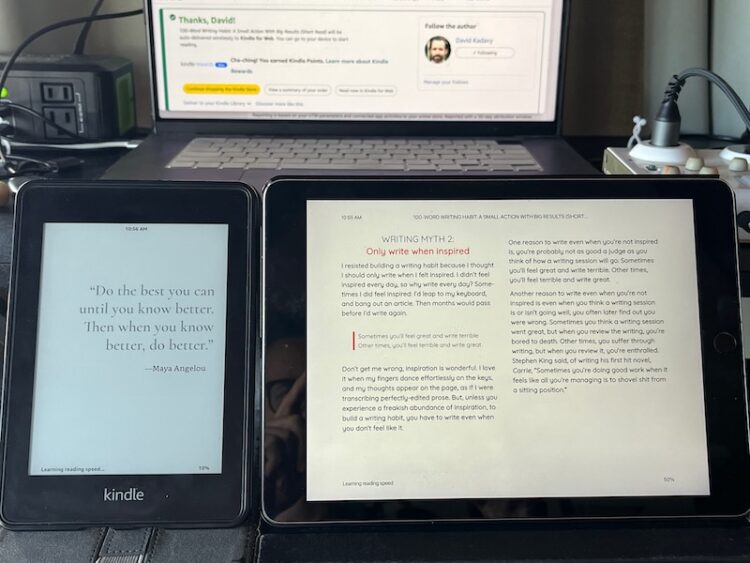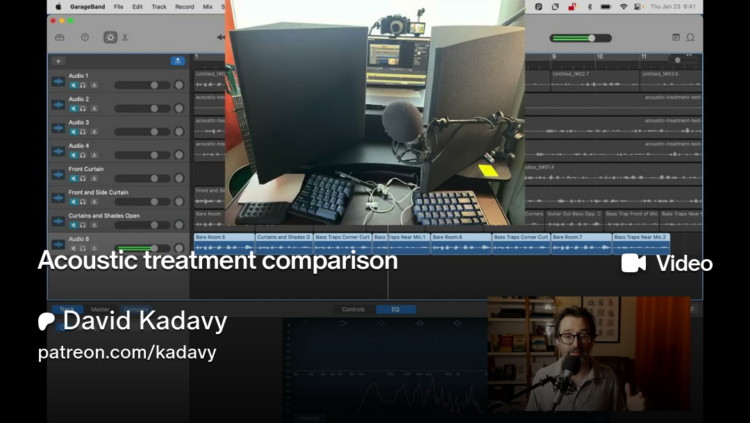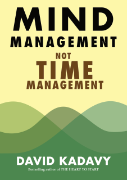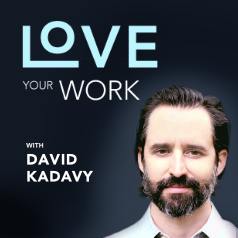Subscribe to blog updates via email »
December 2024 Income Report (and 2024 review!)
To listen to an audio version of this report, join the Patreon »
December’s revenue was $6,298, down from November’s $6,968. Profits were $2,022, down from November’s $3,351.
This is also the last report of 2024. 2024’s revenue was $82,673, down from 2023’s $88,202. Profits were $43,301, down from 2023’s $56,722.
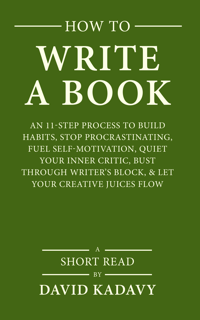
WANT TO WRITE A BOOK?
Download your FREE copy of How to Write a Book »
(for a limited time)

Low profits, high year-end expenses
This month’s profits were pretty low, barely breaking the $2,000 threshold. The last time profits were this low was June, when they were only $2,006. However, February and March were below $2,000.
Intuitively, I’d expect profits to be low in December, due to paying up-front for yearly expenses, such as Quickbooks, WP Engine, and ActiveCampaign. But remember that I’ve been accounting for these expenses on an accrual basis since January 2021.
Outside contractors expense
One anomaly in my expenses this December was $905 towards Outside Contractors. Without that expense, my profit would have been around $3,000, which is at least closer to the 12-month trailing average of $3,608.
Roughly half of that went towards a contractor to help me create the Kindle version of 100-Word Writing Habit. Another half of that was a half-up-front payment for a developmental editor’s help with Finish What Matters. So the first expense will hopefully pay for itself within the next couple months, and the second expense, well, that will take longer.
An opportunity came up to hire a developmental editor already very familiar with my work, and I took it. I figured it would be a good idea to “put my money where I want my mind to be.” If I’ve spent $1,000 towards Finish What Matters, that will be motivating. Of course I expect it will also be very valuable to get the input of this editor.
100-Word Writing Habit Kindle (and ePub) version!
By popular demand, I’ve created a Kindle version of 100-Word Writing Habit. I released the paperback version two years ago, then first offered the PDF in the Kickstarter for the Journal Prompts Workbook.
I hired a contractor to develop the Kindle version, but also spent a lot of time on it myself, trying to figure out how to get custom fonts to work reliably, and reduce the file size to save on delivery costs (15¢ per megabyte!). The original file was 2 MB, the contractor got it down to 1, and I got it down to about 250 kB.
I’ve done my best to try to emulate the experience of the paperback in the ePub.
The launch of the Kindle version was a bit delayed, as I was waiting for Amazon to integrate the Kindle and paperback pages. But you can’t force this unless the paperback is also published through KDP (not possible due to format restrictions).
Supposedly Amazon’s algorithms will integrate them, but it’s been nearly two weeks and no luck. I thought generating some sales on the Kindle edition might help speed up the process, but as of yet still no progress.
300th Love Mondays email!
This week my 300th Love Mondays email went out! For 300 consecutive weeks, every Monday, without fail, the Love Mondays newsletter has been delivered to inboxes.
The first official Love Mondays email went out April 19, 2019. This came after a nineteen-week pilot process, in which my newsletter idea morphed from what I internally called Friday Night Highlights into Love Mondays.
Hard to believe it’s been six years of Love Mondays! As I review 2024, you’ll see it’s going stronger and stronger. If you haven’t yet, sign up for Love Mondays.
How to Sell a Book Amazon saga resolved!
How to Sell a Book is finally published on Amazon KDP paperback! The page for the paperback has long been up from publishing on IngramSpark, but this lifts a dark cloud that has loomed over the lifetime of this book.
Getting this book finally approved has been a roller coaster ride. When I attempted to publish HSB in September, I got several confusing messages from Amazon’s Content Review team. After some back and forth, they blocked the publish of the book.
I eventually reached out to the Alliance of Independent Authors’ member care team. They shared my case history with their contact at Amazon. Several weeks later, I received this email stating that my book was now cleared to be published!
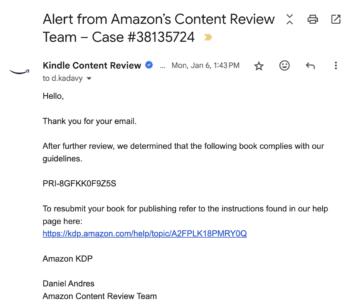
But it wasn’t over yet. I excitedly re-submitted my book, only to get the exact same form-letter rejection from before.
But this rejection letter stated that I could share any permission received to publish the title as is. So that’s what I did. Except I then received the same rejection form letter I had before.
I informed ALLi of this, and a couple weeks later my book was finally published.
This is a huge relief because I had read horror stories in the 20 Books to 50k group about people’s entire accounts getting shut down.
In talking with the Member Care team at ALLi, I learned that the reason Amazon is so quick with the trigger is there are so many low quality and downright scammy books being published, so they’ve been relying heavily on algorithms to do their content review.
I still don’t quite understand why my case still had the appearance at time there were actual thinking humans reviewing my book and making these decisions, only for my book to be blocked over and over.
The problem seems to be that Amazon’s algorithms see a book title with the word “book” in it as a redundant description of what the item actually is. Then to have “book” in the subtitle also is an additional trigger, seen as keyword stuffing.
There was a short window of time when my book was finally unblocked but was still being rejected when I considered submitting with a different subtitle. I didn’t want to deal with that, since the book has already been released and sold with the subtitle it has. Also the principle of Amazon dictating my subtitle felt ridiculous and wrong. Fortunately it’s now resolved.
But I fear it will happen once again if and when I release a Kindle version. Perhaps I should get a head start on that.
Maybe as a fail- or success-safe I could price the Kindle edition really high so that I’m earning the same from it as from my Shopify store. At a 35% royalty rate, that would be a list price of $40.50. On the 35% royalty plan Amazon is free to price a book how they wish, so long as they pay the same royalty.
This experience has reaffirmed the importance of my membership in the Alliance of Independent Authors. I already found it useful for free uploads to BookVault and free changes on IngramSpark, but this was a whole other level. If you sign up, please use my affiliate link.
Affiliate income to come
I’m opening new channels for affiliate income, and preparing to breathe new life into an existing channel, going into 2025.
BYOK: “Bring Your Own Keyboard”
There’s a new line item that appeared under Affiliate income last month, which is appearing again this month. It’s not a lot, but I’m kind of excited about it. BYOK stands for Bring Your Own Keyboard.
Bring Your Own Keyboard is like a digital typewriter for which you attach…your own keyboard. It’s a step up from the AlphaSmart, which doesn’t have cloud storage, but isn’t so expensive like the Freewrite, which does have its own keyboard.
They reached out to me when they were running their Kickstarter, offering an affiliate relationship through the Kickbooster platform. So, I added it to my distraction-free writing devices page, which is the most popular page on my site!
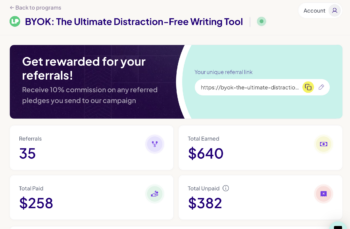
A couple months later, I’ve now generated more than $600 in commissions. I received $50 of that in November, and $90 in December. Their campaign is still accepting late pledges, so the commissions are steadily coming in. So, I’ll steadily be receiving more commissions in future months.
I’m excited about the device myself, and so have backed the Kickstarter and am eagerly waiting for them to ship the device.
Amazon Influencer Rewards program
Amazon has begun an Influencer Rewards program that is boosting my affiliate income slightly. Basically, if you hit certain revenue targets, you receive a bonus. This month, I earned $163 from Amazon, last month $126, which are boosts from the roughly $70 in previous months.
I’m not consciously making any efforts to increase my Amazon referrals, but perhaps I am subconsciously, which I guess is the idea.
New ActiveCampaign Review coming soon!
A major source of my affiliate revenue over past years has been through ActiveCampaign. I’ve earned over $100,000 on my referrals, mostly from a series of articles and videos I did eight years ago.
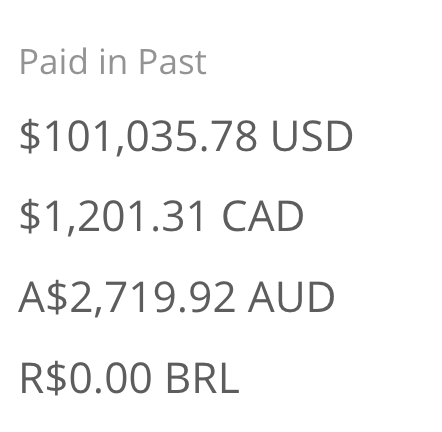
It got to be a running joke between me and my mastermind partner how badly I was dragging my feet on making a new ActiveCampaign review. I kept saying it was something I should do, but something else always took priority.
Part of my delay was due to still considering switching to another provider. But after implementing RSS-triggered publishing for Love Mondays, and once again considering other ESPs, I’ve reaffirmed my commitment to the platform. In the course of those projects, I also got a head start on some of the research necessary to do such a review.
I have written, shot, and am editing an updated ActiveCampaign review video for my YouTube channel. I suppose I’ll also adapt it to an article as well. I’ve already released one simpler video in which I evaluated deliverability between ActiveCampaign and ConvertKit.
I don’t suspect I’ll be able to match the success I’ve had with the reviews I did eight years ago – I made quite a few comparison and review videos then, and I imagine the competitive landscape has changed. But I’m excited to practice my video chops and boost the revenue in this affiliate-income channel.
Consolidating book earnings, by all formats
I’ve made a change in how I report book earnings, starting with this report. For the first time, I’m consolidating the earnings of all formats into one. So instead of reporting, say, the earnings for the Kindle edition of Mind Management separate from the earnings for the paperback edition, I’m reporting them all at once.
The list of all the formats across all the titles was getting pretty unruly, and seeing the breakdown by format doesn’t have much influence on my decision-making process. I of course have access to those numbers through other reports, anyway.
If you really really miss seeing the numbers across all formats and you’re a Patreon supporter, let me know and maybe I can make the more granular data a benefit for patrons.
30 hours meditation
I have now completed 30 consecutive days of one hour of meditation. Long-time readers will remember when I first did 89 days, based on the Naval Ravikant meditation challenge of doing 60 consecutive days.
I’ve since done at least two other 60-day challenges. I don’t think I’ll do 60 days this time, as I have a highly-anticipated vacation that would make it a good idea for me to miss three days. But perhaps I’ll pick it up right after.
I believe now more than ever that spending a lot of time meditating is a very productive activity. With technology changing so fast in the age of AI, and more and more information coming at us, it’s increasingly true that being effective is not a matter of how much of your time you spend in motion. Contemplating what actions to take is more valuable than constantly moving.
This is especially true after the year I just had, as I was doing a lot of stuff that simply demanded a lot of my time, such as setting up and optimizing the Shopify store, and running a Kickstarter campaign. I wasn’t making big profits so it was hard to justify outsourcing any of this, and I wanted to understand it anyway.
After 30 days of meditation, I’m starting to see things more abstractly again, which is where I want to be. The time I spend taking action feels more efficient, and my wildcard ideas are taking on more presence in my mind. I’m wasting way less time and attention on social media, and on media in general.
After long challenges like this, I find I do pretty well with a maintenance hour or three- or seven-day streak when I feel it’s needed. I wonder why I don’t simply meditate an hour a day as part of my normal routine. In the past I’ve felt like I’ve hit the point of diminishing returns after several weeks, but perhaps that’s just a local maximum. I’ll consider making long meditation sessions a part of my routine.
Progress on a novel
My pen-name/alter-ego is making progress on his first novel. I’ve now started my third hand-written notebook.

Much of the first notebook was spent finding my footing, and on an interlude that almost certainly won’t make it into the final product, but the second notebook is all useable first draft.
I’m finding this to be a great motivational framework for writing my first novel:
- Write evenings, on the couch
- As a substitute for reading fiction, write fiction you want to read
- Two hand-written pages a day
- Stop in the middle of a sentence (sometimes a word), to start easily the next day
- 68-page saddle-stitched notebooks
The 68-page notebooks are crucial, as is the fact that they are saddle-stitched. Reaching the end of a notebook is a milestone, every 34 days. Reaching the halfway point of a notebook (clear because it’s saddle stitched) is a milestone, every 17 days. Then every day you’re trying to write two pages.
Once I feel like I’ve written a full novel (I estimate around the end of the third notebook or middle of the fourth), I’ll hand-type from these notebooks, probably editing as I go. Maybe my BYOK will have arrived by then. If not, maybe I’ll use my AlphaSmart. Editing enough to be ready for publish will be the toughest part, but publishing under a pen name takes the pressure off.
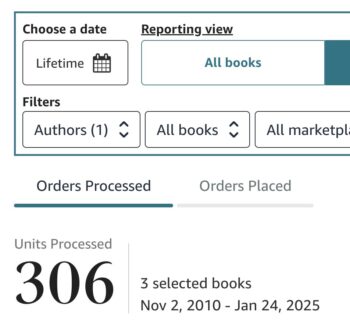
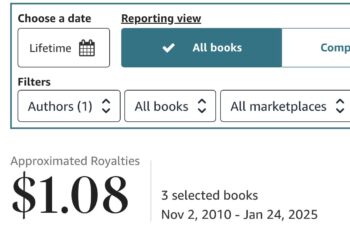
By the way, my pen name has 300 Kindle downloads of his books, and has made $1!
2024 in review
You might think it sounds bad that my revenue dropped from $88,202 in 2023 to $82,673 in 2024, and that profits dropped from $56,722 to $43,301. But consider that last year revenue dropped from $116,023 to $88,202, and profits dropped from $69,256 to $56,722. So, after a drop of 24% and 18% in revenue and profits, respectively, this year they dropped again by 6% and 24%.
| Category | 2022 | 2023 | 2024 | 2022-2023 Change | 2023-2024 Change |
|---|---|---|---|---|---|
| Revenue | $116,023 | $88,202 | $83,007 | -$27,821 | -$5,195 |
| Profit | $69,256 | $56,722 | $45,704 | -$12,534 | -$11,018 |
So yeah it’s an even worse drop than last year – not in revenue, but in profit.
Some of that precipitous decline shouldn’t be a surprise. 2022 was my best year ever, thanks in large part to Mind Management, which brought in $57,538 in sales. In 2023, that dropped to $47,292, and this year that dropped again, to $32,181. It’s only natural that a book that’s been out four years would have fewer sales.
But that can’t account for all of the decline. I released several new products this year: the habit wristband; the Journal Prompts Workbook, both in the special Kickstarter edition, and the Wirebound edition; and How to Sell a Book.
Revenue by category
In fact, book revenue barely declined more than 1%. Here’s the breakdown of revenue by category.
| Category | 2022 Revenue | 2023 Revenue | 2024 Revenue | 2022-2023 Change | 2023-2024 Change |
|---|---|---|---|---|---|
| Book Sales | $87,555 | $65,907 | $63,666 | -$21,654 | -$2,241 |
| Affiliates | $19,649 | $18,357 | $15,574 | -$1,292 | -$2,783 |
| Misc. Products | $4,278 | $1,593 | $624 | -$2,685 | -$969 |
| Services | $1,871 | $207 | $400 | -$1,664 | +$193 |
| Reader Support | $2,670 | $2,138 | $1,717 | -$532 | -$421 |
When Mind Management, Not Time Management brought in $47,292 in 2023, that was 73.4% of the $64,440 in book revenue. This year, when it brought in $36,743, that was 57.7% of the $63,666 in book revenue. So the new book and workbooks helped fill that gap.
The only category that was up over last year was Services, and that’s an intentionally small category anyway. Reader Support is way down since of course quitting the podcast; Misc. Products (formerly Digital Products) are down, since I’ve been sunsetting my past courses; and Affiliate revenue is down, as my ActiveCampaign assets have grown stale.
Affiliate revenue declining (recovery on the way)
Affiliate revenue is a significant portion of my revenue, but that revenue has dropped about 20% over the past two years. Here is the detailed breakdown from Quickbooks.
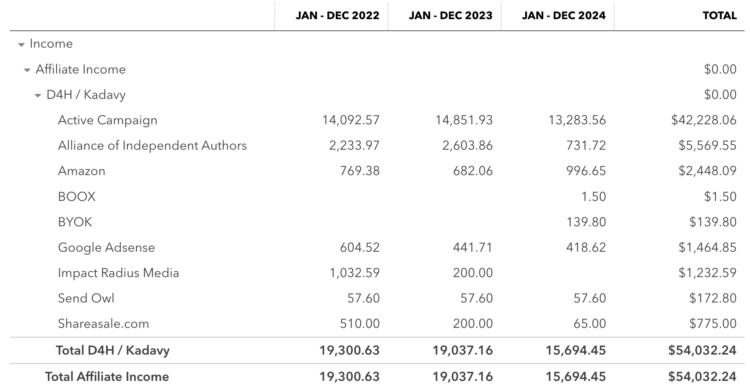
ActiveCampaign revenue has been surprisingly stable given how long its been since I updated my promotional assets. It did drop about $1,600 over last year.
I hadn’t realized Alliance of Independent Authors revenue had been that high. That dropped nearly $2,000. I assume because a main channel was my IngramSpark promo code page, and Ingram stopped charging for initial uploads. My BookVault promo code page is apparently not doing enough to fill the gap.
“Impact Radius” was Hostgator, mostly coming from create WordPress blog post on the Design for Hackers website. I don’t know the cause of losing that $1,000 in revenue, but don’t feel motivated to investigate.
“Shareasale.com” is mostly WP Engine, and I’m not quite sure where those referrals were coming from.
I’ve overall neglected affiliate revenue over recent years, so I can focus on my books. I intentionally ignore opportunities just because keeping tabs can be a lot of mental overhead. But it’s an important revenue channel. I feel 60% confident I can increase Affiliate revenue in 2025.
Misc. Products revenue declining
The Misc. Products category has lost more than $3,500 revenue over the past couple years. This is because I’ve been sunsetting the courses I created in the past.
This category got repurposed from “Digital Products,” and so now includes things like the habit wristband.
Now that I’m improving my efforts with video, the chances I’ll release a new course are increasing. Something related to Digital Zettelkasten would be the most marketable. Something related to Mind Management or How to Sell a Book would also be options.
But, I’m not sure about this. I’m 30% sure I’ll release a new video course in 2025.
Reader Support (Patreon) revenue stagnant
I’m trying to recover Reader Support revenue by consistently creating bonus content for the Patreon. But, as I’ve attracted new members, old ones have left. I made $152 from Patreon in January, and $130 this month, in December.
I still have yet to aggressively market the Patreon, trying to bring in new members. I’m unsure about it as a viable revenue channel, but my confidence is growing as I add to my catalog of bonuses.
I’m 70% sure I’ll still have a Patreon by the end of 2025. I’m 40% sure I’ll make more from Patreon in 2025 than 2024.
Direct sales exceeded expectations
My direct sales revenue in 2024 exceeded expectations. I know that because at the beginning of the year, I was only 30% sure I could increase the 6-month trailing average of direct sales to 30% or higher.
Over the past six months, my total book revenue has been $36,947. $11,094 of that has been from direct sales – exactly 30%!
That’s helped along greatly by the fact there’s a Kickstarter and a new book launch within the six-month window.
But it’s kind of crazy how the mix of revenue sources has changed over the years. Here’s my breakdown of income, by channel, for books and ebooks (Direct Sales includes some audiobooks, but it’s a negligible percentage of revenue).
- Amazon: $29,028
- IngramSpark: $4,188
- Wide eBooks: $1,096
- Direct Sales: $15,409
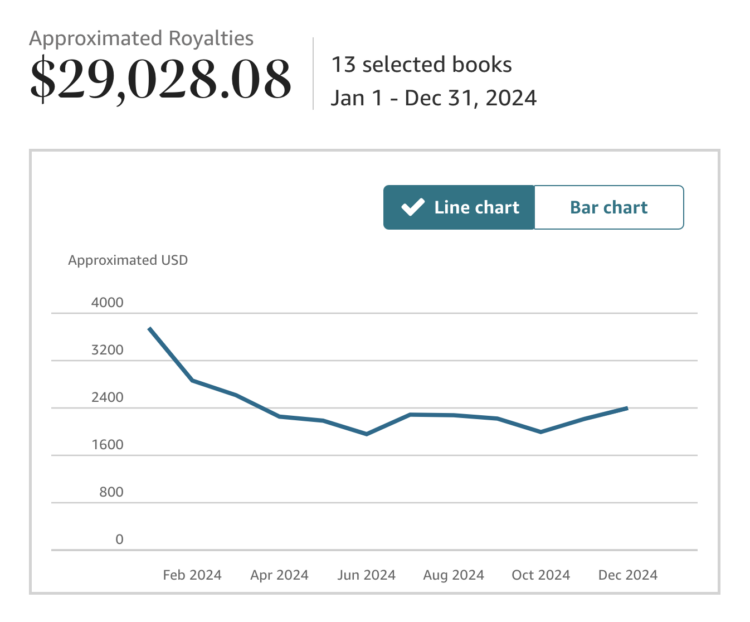
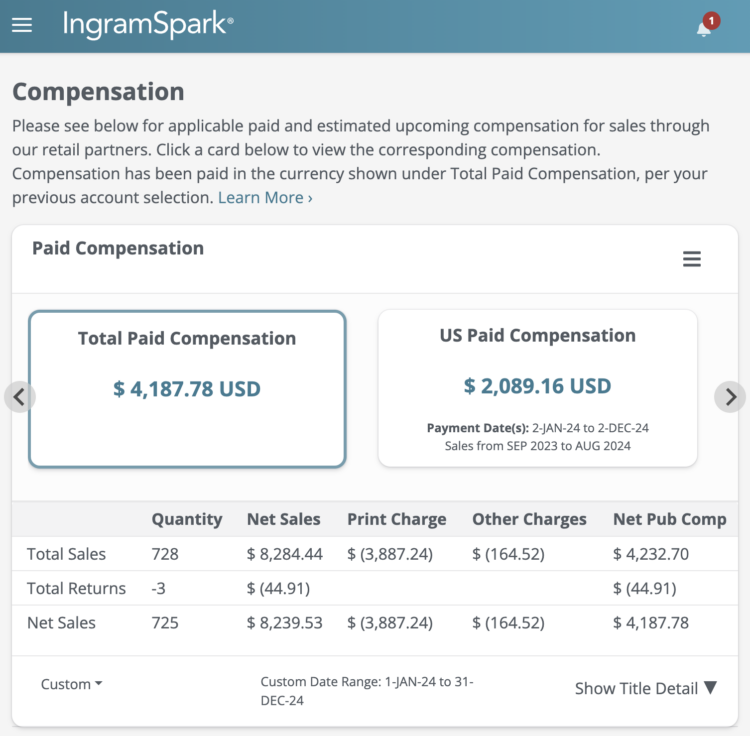
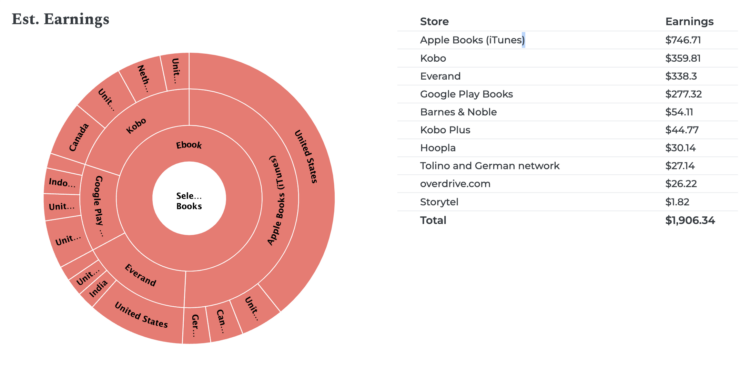

That’s a massive departure from the early days of my self-publishing journey. During the first year of The Heart to Start, Amazon accounted for about 94% of book and ebook sales. This past year, they accounted for only about 58%.
I’m now 50% sure that by the end of 2025, my 6-month trailing average share of direct sales will be higher than 30%. That outcome will be greatly affected by whether I release a new book within that timeframe.
Servicing Direct Sales revenue
As I’ve mentioned many times before, these Direct Sales come at a cost. I have to print and ship the books, and this year started hiring a warehouse to process orders. Accounting for these expenses accurately on a monthly basis is a challenge, but now that I’m closing out a year I’m sure I can get a ballpark figure.
Here are the main expenses for servicing my Direct Sales revenue:
- Book Printing: $4,992
- Book Shipping & Handling: $1,990
- BookFunnel: $219
- Shopify: $554
- Total: $7,755
That makes for a margin of almost exactly 50%. Some of the above expenses are for books still sitting in the warehouse, which makes those expenses higher than they are, and I didn’t account for payment processing fees, which makes those expenses lower than they are. But that’s just about everything.
If I compare that $7,654 of profit from Direct Sales to other sources of book income, of the $41,966 of gross margin from all book sales channels, Direct Sales would make up 18%. Still quite a bit!
Will Amazon be the beneficiary of direct-sales growth?
Seeing how much I’m making selling direct, and how little I’m making on wide ebooks (PublishDrive), I’m starting to wonder whether it’s worth it to deal with wide sales. Yes, it’s not much work once you’ve uploaded a book, but it adds operational complexity, and for what?
The only reason I can think of to keep selling wide ebooks is to have a better chance at BookBub Featured Deals. If I stopped selling ebooks wide, maybe that would push some of those would-be wide customers to purchase directly from me.
Which makes me wonder, if wide authors come to that conclusion, and adopt an Amazon-plus-direct strategy, won’t Amazon be the ironic beneficiary? Maybe not as much as the indie author would be, which is the most important thing.
Love Mondays grew 30%!
My Love Mondays subscriber base has continued to grow this year, and the rate of growth has been increasing over the years.
- In 2020, I lost 4.86% of subscribers
- In 2021, my subscriber base grew 3.85%
- In 2022, my subscriber base grew 10.59%
- In 2023, my subscriber base grew 17.6%
- In 2024, my subscriber base grew 30.5%
At the end of last year I had 8,720 subscribers, and was 70% confident I could grow that to over 10,000 subscribers. I ended the year with 11,369 subscribers.
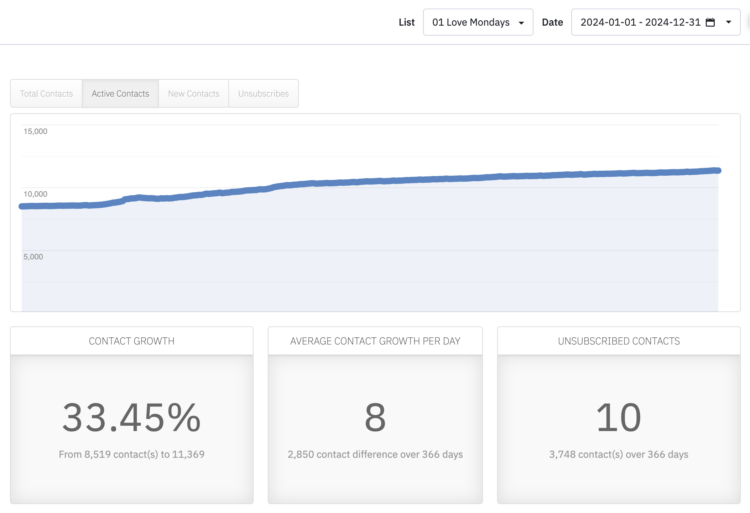
Note this shows a lower number of subscribers at the beginning of the year than my EOY 2023 report did (don’t know why), so growth rate is inflated.
What about engagement?
With this growth, open rates haven’t declined much. The average open rate for the last twelve emails of 2024 was 20.4%. The average open rate for the last twelve emails of 2023 was 22.1%. My average opens per email for that 2024 cohort was 2,300, and for that 2023 cohort was 1,914, so about a 20% increase in opens.
Clearly that’s a lower open rate, but with more ubiquitous privacy controls, it’s getting harder to tell when leads are opening or clicking in emails. These open rates don’t include “Apple Privacy” opens, by the way. The typical email when including that has an open rate of about 38%.
According to ChatGPT, 20–25% open rate is a solid open rate, higher than 30–35% and you may be pruning too much, and under 10% and you’ll have deliverability problems. So I’m incubating some thoughts on how to clear off inactive subscribers, but it’s not yet urgent.
Where did the growth come from?
Where did all these new subscribers come from? Mostly from Meta Ads.
I gained 2,649 active subscribers this year. My Meta ads generated 4,785 leads. What happened to the rest of them? Well, as I talk about in a patron-only screencast, I’m sure to aggressively quarantine and warm-up these leads before keeping them on my list.
1,893 of those leads from Meta Ads are active on Love Mondays, and joined in 2024 (to rule out existing subscribers).
I spent $2,447 on these lead ads, so I spent about 51¢ per lead. I spent $1.29 per new active lead. So about 40% of my new leads from Meta Ads become active leads.
Not all leads are created equal
From this analysis, I learned there can be big differences between the value of leads, depending upon where they came from, and what attracted them.
Leads generated by Meta ads who signed up to receive a “30 Journal Prompts” PDF and those who signed up to receive a free download of How to Write a Book, were about equally as likely to become active subscribers.
But those who signed up for the free ebook were much more likely to become paying customers! Those who signed up to receive the journal prompts became customers at a rate of about 0.2%. Those who signed up to receive the ebook became customers at a rate of 0.77%.
That’s a very low base rate, but plugging it into an A/B test calculator, the latter has more than a 98% chance of winning.
Assuming a generous 50¢ per lead cost of acquisition, I had to spend about $227 to get a new customer advertising the journal-prompts lead, and about $65 to get a new customer advertising the free ebook.
Which lead magnet people signed up for didn’t make much difference in whether they became active subscribers. Those who signed up for the journal prompts were 41% likely, whereas those who signed up for the ebook were about 40% likely.
I’m glad I looked into that. I’m going to immediately stop advertising the journal-prompts lead, and instead allocate that budget to the ebook lead.
Twitter leads not so bad
By analyzing the likelihood leads became active or customers, I also found that leads from X (Twitter) weren’t so bad compared to those from Meta Ads.
I paid $90.42 on Twitter ads in 2024, which brought me 258 new leads. At 35¢ per lead, that’s much better than Meta Ads, which was 51¢ per lead. But 180 of those leads became active, which is about 70% – also much better than Meta Ads. 3 of those leads became customers, so I paid about $30 per customer – less than half what I paid for a new customer on Meta.
That’s a low base-rate from which to detect a better performance, and there’s a good chance those Twitter leads are saturated with people who were already familiar with my work, but that performance is so much better, it’s hard to ignore.
Even though I found X ads successful, I stopped using them, because I found my organic reach declined. That was because lots of people on X automatically block every advertiser they see, which leads to a penalty by the algorithm.
Last I saw, X had added some friction to the process of blocking accounts, so that effect might not be so pronounced. My organic reach on X sucks anyway, so maybe I don’t care. Or, I could try advertising through a separate account.
Sustainable lead growth?
It doesn’t take a genius to see that with the prices of my books, I can’t pay $227, nor $65, nor $30 for each new paying customer and build a sustainable business. Yes, “paying customer” only assumes they bought on my Shopify store, and people buy from other channels, but still.
Looking at these numbers made me wonder how this compares to simply advertising my products to get new email subscribers through Meta Ads.
My Meta dashboard shows that I spent $4,435 on ads with a Sales objective, and that it led to 228 results. So that’s $19.45 per purchase. My Shopify admin shows an AOV for my biggest campaign of $17.68. So that’s a loss, but a small one, and lots of those who viewed the campaign probably bought on Amazon, anyway.
Even if I did lose $2 per book, a sample of 10 recent new customers from Facebook showed 6 of them subscribed to my email list. I don’t know for sure how active they are, but there’s a lot of wiggle room to beat even X’s $30 per customer/email subscriber.
Organic growth
Removing all the new subscribers I know I paid for in 2024, it seems the organic growth of Love Mondays was about 590 new subscribers, or 6.8%. That’s lower than the growth rates of 2023 and 2022, which were 10.59% and 17.6%, respectively, so that’s concerning. I need to think of how to encourage more organic growth.
Reviewing 2024 predictions
Before I get into my plans for 2025, let’s look at what predictions I had for 2024.
- I was 70% confident I would finish the Finish What Matters manuscript. I did not finish this. I got as far as a 25,000-word outline. In 2023, I had been 60% sure I’d finish, and I of course didn’t then, either.
- I was 70% confident I would grow Love Mondays to at least 10,000 subscribers, and I did.
- I was 60% confident I would grow Direct Sales to 10% of 6-month trailing average book sales revenue. I did.
- I was 30% confident I would grow Direct Sales to 30% of 6-month trailing average book sales revenue. I did.
I just imported all my prediction history from the now dormant PredictionBook into Fatebook. Here is my prediction performance across more than 70 forecasts, (not all business-related, but many).
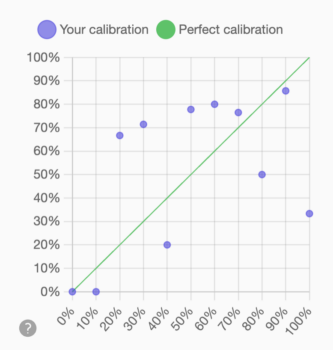
Looking at the details, which you can see on my Fatebook profile, what sticks out most is that when I’m 30% confident of something it happens more often than not. In fact, it happens 71% of the time, out of 7 forecasts.
When I’m 50% confident, across 9 forecasts, it happens 78% of the time.
My most robust confidence level is 70%. Across 17 forecasts, such events occur 76% of the time.
I think I’d be better-calibrated if I had divided all forecasts into three buckets: Definitely not (10%), Maybe (75%), and Definitely (90%). 75% seems high for a “Maybe,” but that seems to be about the occurrence rate of anything I’m 20–80% confident will happen.
What will I do in 2025?
Now to think about what I want to accomplish in 2025? In short, I want to finish Finish What Matters, publish a novel under my pen name, and do more video.
Direct Sales will continue to be important, but now that I have the basics set up, I don’t want that to be as dominant a focus as it was last year. There’s so much more I could do, but I can only prop up my back-catalog so much through promotion. I need to deliver another magnum opus.
Top 2025 priority: finish Finish What Matters
My top priority in 2025 is to finish Finish What Matters. It’s embarrassing to have better-than-chance predictions of finishing this book the last two years, and to have not finished.
But, it’s an appropriate illustration of just how unruly creative work can be, and how often we struggle to do what we intend – which is a great case for the practice of making forecasts about your own behavior.
Because of these “failed” forecasts, I’m tempted to forecast an even lower chance of finishing it in 2025. But the fact remains I am much further along. Some very important incubation has happened over the past couple years, and I’ve learned a lot about my own relationship with finishing creative projects.
I’m going to re-up with my favorite forecast confidence this year: I am 70% confident I will finish the manuscript of Finish What Matters in 2025.
Second priority: publish a novel under my pen name
My second priority is so integrated with my first priority, it’s almost my first priority.
Throughout the course of writing Finish What Matters, I’ve had to ask myself uncomfortable questions about what “matters.” One of the conclusions I’ve come to is, while I’ve learned a lot about getting creative work done writing the Getting Art Done series, I’d be succumbing to a form of Resistance if I didn’t use what I’ve learned toward something creative on a deeper level. Learning about getting creative work done so I can write about creative work feels too self-referential.
I’ve been slowly over the past several years using the Surround and Conquer technique to soften the defenses around writing a work of fiction. I have had a pen name for about two years now, who has published some short stories on Kindle.
It feels appropriate to include a personal storyline in FWM about coming to this realization and finally publishing my first novel. Aside from Surround and Conquer, doing it under a pen name would be another way of using the very advice within the book to finish what matters.
Using the very conservative criteria of a minimum word count of 30,000 words, I am 70% confident I or my pen name will publish a novel in 2025.
Maybe: more YouTube
I’ve been slowly over the years buying the basic equipment necessary to make videos, and improving my video production skills. I’ve also sharpened my sensitivity for engagement on video by making videos on TikTok.
But, while I’ve seen growth on TikTok, I haven’t seen that translate into anything tangible outside of TikTok. And the issues with the ban in the U.S. make it an even less appealing long-term focus.
I’m late to the party, despite having been waiting outside, but YouTube is looking more and more appealing. I’ve been using YouTube since it started in 2005, and my oldest video currently posted is 16 years ago, but I’ve never taken it seriously.
I miss podcasting but it’s such a hard channel to grow I can hardly motivate myself to try it again. YouTube at least gives you the opportunity for your content to be discovered.
But, I don’t want content creation for YouTube to overshadow my bigger priorities. I’m 50% confident I will publish at least one hour of content on YouTube (besides shorts and interviews) in 2025. (The privately-published videos I make for Patreon don’t count either.)
Maybe: a video course
With my improved video-production skills and resources, I’m thinking about a video course. It could be fun to make, and would almost definitely boost revenue. However, it’s still a higher priority for me to finish Finish What Matters. So, I am only 30% confident I will release a new video course in 2025.
Maybe: more Patreon
Patreon doesn’t make me much money, but each dollar on Patreon feels like ten. During 2024, I used it as a place to casually share knowledge that feels too detailed or idiosyncratic to stand a chance on public social media.
But, I haven’t directly pushed the Patreon at all. Now that I have a growing library of screencasts and videos on there, I may feel more comfortable actively trying to get more members.
At the same time, I’m wondering, if I can’t grow the Patreon, maybe I should either shut it down or find a similar outlet on which to share more specific things close followers might enjoy? So, I am 70% confident I will still have a Patreon at the end of 2025, and I am 50% confident I will make more from Patreon in 2025 than 2024.
Maybe: Substack
Twitter isn’t what it used to be and Patreon isn’t for me what I feel it should be, so one potential channel to direct my energy to could be Substack. I’ve dabbled in it only slightly in the past, and just kind of like it. The gravitational pull hasn’t been strong enough to take me away from where my initial creative energy tends to go, which is X.
I’ve been running a small experiment on Substack, and have fantasized about publishing there more regularly. But again, I don’t want to distract myself from my top priorities this year, so I’m proceeding with caution. So, I am only 20% confident I will have at least 1,000 Substack subscribers by the end of 2025.
Sustain: Direct Sales
2024 was a great year for my Direct Sales, but it was a lot of work. Now that my basic infrastructure is in place, I merely hope to sustain the level I’m at. So, I am 50% confident direct sales will account for 30% or more of my book revenue by the end of 2025.
Sustain: Love Mondays
2024 was a good year of growth for Love Mondays, but it was also a lot of work. While I’ll continue to do my best to make the best content possible, I will reduce my focus on growth, so I can work on higher priorities. So, I am 70% confident my Love Mondays subscriber base will be between 12,500 and 15,000 at the end of 2025. (12,500 would be a 10% growth rate).
In sum: 2025 predictions
Here I’ve collected all my predictions for 2025.
- I am 70% confident I will finish the manuscript of Finish What Matters in 2025
- I am 70% confident I or my pen name will publish a novel in 2025
- I am 60% confident I will increase Affiliate revenue in 2025, versus 2024
- I am 30% confident I will release a new video course in 2025
- I am 70% confident I will still have a Patreon at the end of 2025, and I am 50% confident I will make more from Patreon in 2025 than 2024
- I am 20% confident I will have at least 1,000 Substack subscribers by the end of 2025
- I am 50% confident direct sales will account for 30% or more of my book revenue by the end of 2025
- I am 70% confident my Love Mondays subscriber base will be between 12,500 and 15,000 at the end of 2025
New on Patreon: acoustic treatment comparison
More than two years after buying a cabin in the country, I’ve finally upgraded the acoustics of my home office. In the latest Patreon bonus video, I compare and contrast the audio quality when recording, given various treatments.
I’ve been adding about a video a month for nearly a year now, so join at the $5 a month level to access them all.
Income
Book Sales
| Mind Management, Not Time Management | $2,253 |
| 100-Word Writing Habit | $469 |
| 100 Journal Prompts Workbook | $294 |
| How to Sell a Book | $818 |
| Digital Zettelkasten | $1,006 |
| The Heart to Start | $264 |
| How to Write a Book | $98 |
| Total Book Sales | $5,202 |
Misc. Products
| 100-Word Habit Wristband | $27 |
| Signed Book Plates | $0 |
| Total Misc. Products | $27 |
Affiliates / Advertising
| Active Campaign | $686 |
| Alliance of Independent Authors | $0 |
| Amazon | $163 |
| BYOK | $90 |
| Total Affiliates | $939 |
Reader Support
| Patreon | $130 |
| Total Reader Support | $130 |
Services
| Clarity | $0 |
| Medium | $0 |
| Total Services | $0 |
| GROSS INCOME | $6,298 |
Expenses
General
| Accounting | $35 |
| Book Printing | $0 |
| Outside Contractors | $905 |
| Quickbooks | $32 |
| Shipping and Handling | $308 |
| Total General | $1,280 |
Advertising
| Amazon | $1,858 |
| BookBub | $0 |
| $40 | |
| Meta | $699 |
| Influencer Marketing | $0 |
| Product Samples | $0 |
| Total Advertising | $2,597 |
Hosting
| ActiveCampaign | $150 |
| Bookfunnel | $30 |
| Drafts | $2 |
| Dropbox | $10 |
| Fathom Analtyics | $14 |
| Libsyn | $5 |
| Namecheap | $17 |
| Obsidian Publish | $10 |
| SendOwl | $9 |
| Shopify | $39 |
| Ulysses | $3 |
| WP Engine | $96 |
| Zapier | $14 |
| Total Hosting | $399 |
| TOTAL EXPENSES | $4,276 |
| NET PROFIT | $2,022 |

